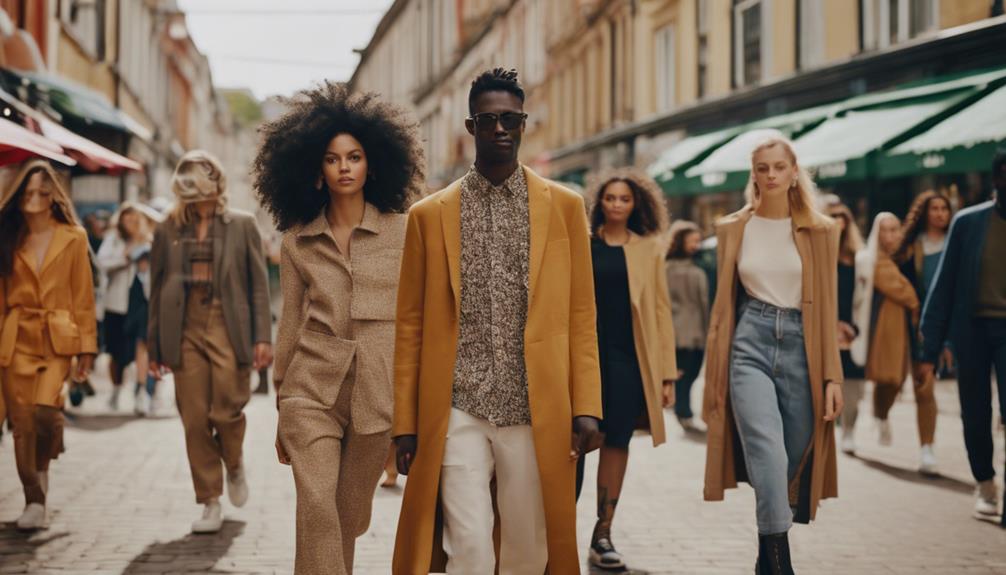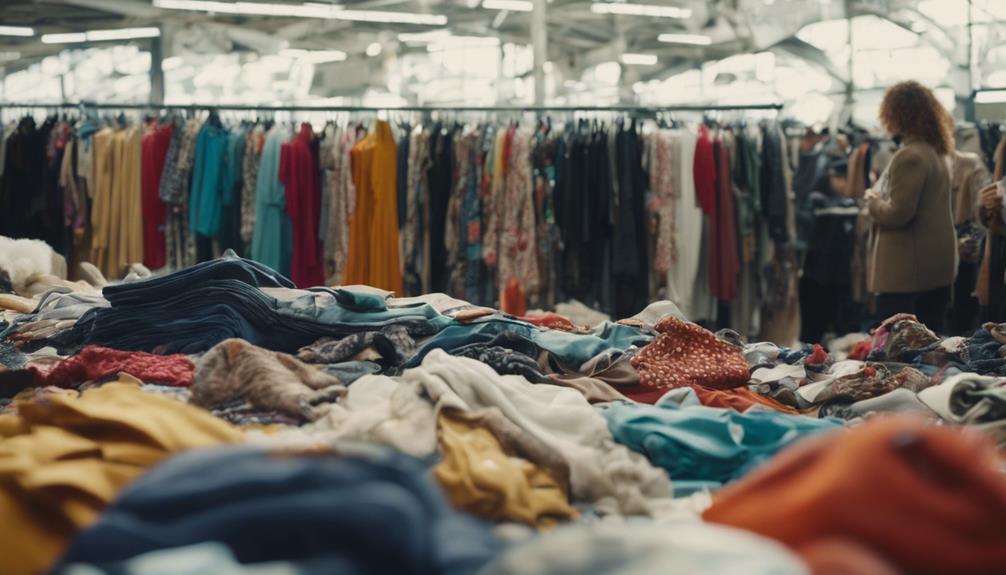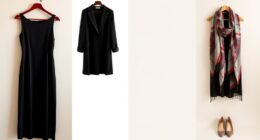Sustainable fashion is not just a small market; it is evolving into a significant player in the retail industry. With a market value expected to rise from $7.7 billion in 2022 to $13.2 billion by 2028, it is evident that consumers are placing more importance on eco-friendly alternatives. Millennials and Gen Z are at the forefront of this movement, actively seeking out sustainable options. Brands that embrace these principles are experiencing improved reputations and customer loyalty. Therefore, even though it may seem insignificant now, the sustainable fashion movement is poised for explosive growth. Stay tuned to find out what this means for fashion and your wardrobe!
Key Takeaways
- Sustainable fashion is rapidly growing, with the market projected to reach $13.2 billion by 2028, indicating it's moving beyond a niche status.
- Consumer demand for eco-friendly products is increasing, particularly among millennials and Gen Z, driving mainstream adoption of sustainable practices.
- The second-hand and rental fashion markets are flourishing, appealing to eco-conscious consumers and demonstrating sustainability's broad market potential.
- Sustainable fashion brands are gaining competitive advantages, enhancing their reputation and consumer loyalty through ethical practices.
Definition of Sustainable Fashion
Sustainable fashion is a movement that focuses on reducing environmental harm and promoting ethical labor practices in clothing production. This approach emphasizes sustainability by prioritizing materials that are eco-friendly, like organic cotton and recycled fabrics.
As a consumer, you're encouraged to reflect on the environmental impact of your clothing choices, recognizing that the fashion industry has considerable room for improvement.
The sustainable fashion sector aims to tackle the staggering 92 million tons of waste generated annually. By advocating for recycling and upcycling, it seeks to minimize this issue and change how you view clothing. Instead of constantly buying new items, sustainable fashion encourages you to adopt a mindset of minimalistic consumption and longevity in your wardrobe.
As a consumer, your choices can drive change within the fashion industry. The demand for transparency and eco-conscious practices is growing, with the global sustainable fashion market projected to reach $10.3 billion by 2026. This shift reflects a collective desire for a more ethical and sustainable approach to fashion, proving that your voice as a consumer can considerably impact the industry's future.
Fast Fashion Explained

Fast fashion refers to the quick production and distribution of inexpensive clothing that mimics current trends, encouraging a cycle of rapid buying and disposal. This industry thrives on the idea that you can constantly refresh your wardrobe without breaking the bank. However, it comes with a significant environmental impact. Fast fashion accounts for about 10% of global carbon emissions, exacerbating climate change and harming the planet.
You might be shocked to learn that around 60% of clothing produced by fast fashion brands ends up in landfills or is incinerated within a year. This alarming statistic highlights the unsustainable lifecycle of these garments. Between 2000 and 2014, clothing production doubled, fueling overconsumption and generating more waste than ever before.
While the allure of cheap, trendy clothing is hard to resist, it's vital to reflect on the consequences. Only about 1% of textiles used in fashion are recycled into new garments, pointing to a pressing need for sustainability in fashion. By understanding the true cost of fast fashion, you can make more informed choices and contribute to a shift towards a more sustainable future.
Economic Impact of Fast Fashion

Fast fashion's economic drain on consumers is staggering, with billions lost each year while only a fraction of textiles gets reused.
You mightn't realize how your purchasing habits contribute to overconsumption and a growing waste crisis.
Let's explore how these practices impact both your wallet and the environment.
Economic Drain on Consumers
The economic burden of fast fashion weighs heavily on consumers, draining approximately $500 billion each year while contributing to a staggering amount of waste and environmental degradation. This unsustainable model encourages consumer behavior that prioritizes quantity over quality, leading to an overconsumption mindset. In fact, around 90.2% of people buy from fast fashion brands often, which exacerbates the issue.
As production doubled between 2000 and 2014, 60% of clothing produced ends up in landfills within a year. Only about 1% of textiles are reused for new garments, illustrating the inefficiency of this cycle. The economic drain isn't just personal; it's a broader issue impacting the Sustainable Fashion Market as well.
While fast fashion thrives on low prices, the hidden environmental and social costs are immense, contributing to 10% of global carbon emissions. This economic impact forces consumers to reassess their purchasing habits.
Embracing sustainable fashion can alleviate some of this burden, promoting a healthier relationship with our environment while supporting ethical practices. By choosing sustainably, you can help shift the market towards a more responsible future.
Environmental Cost Analysis
Sustainable fashion tackles the staggering environmental costs linked to the fast fashion industry, which contributes greatly to global carbon emissions and textile waste.
Fast fashion accounts for 10% of global carbon emissions and 8% of greenhouse gas emissions, creating a significant environmental burden. Every year, the industry generates about 92 million tons of textile waste, with 60% of clothing ending up in landfills within just one year. This unsustainable cycle leads to a massive loss of valuable resources, as only 1% of textiles are recycled into new garments, resulting in an annual waste of $100 billion worth of materials.
As sustainability becomes a priority, a change in consumer behavior is essential. You can make a difference by choosing sustainable options that minimize environmental impact. By supporting brands focused on eco-friendly practices, you help reduce the staggering water consumption associated with fast fashion—like the 3,781 liters needed to produce just one pair of jeans.
If current trends continue, fashion waste could rise to 148 million tons by 2030. It's time to rethink your choices and embrace sustainable fashion for a healthier planet.
Overconsumption and Waste Issues
Overconsumption in the fashion industry leads to staggering economic losses and environmental harm, as consumers waste billions on disposable clothing that quickly ends up in landfills.
You're part of a system where fast fashion contributes to 10% of global carbon emissions, reflecting its massive economic costs. Each year, you waste around $500 billion on fashion that's designed for short-term use, with only 1% of textiles being reused for new garments. This inefficiency only highlights the concerning waste issues we face today.
Shockingly, about 60% of clothing produced finds its way to landfills within a year, revealing the dire consequences of our disposable habits. The clothing utilization rate has dropped by 36% over the last 15 years, a clear sign of overconsumption that's damaging both your wallet and the planet. By 2030, fashion waste is projected to soar to 148 million tons, making it essential for you to rethink your purchasing habits.
Embracing sustainable fashion isn't just a trend; it's a necessary shift in consumer behavior that can combat these economic and environmental challenges. Your choices can help alter the course of this alarming trajectory.
Consumer Behavior Trends

As consumers become more aware of environmental issues, a noticeable shift towards eco-conscious shopping habits is emerging, particularly among younger generations.
Millennials and Gen Z are leading this charge, reshaping consumer attitudes around sustainability and ethical fashion. Here are some key trends you should know:
- Prioritization of Sustainability: A significant 71% of millennials now place sustainability at the forefront of their shopping decisions, signaling a dramatic change in consumer values.
- Popularity of Second-Hand and Rental Markets: As you seek more eco-friendly options, the second-hand and rental fashion markets are gaining traction, providing you with sustainable choices that reduce waste.
- Willingness to Pay: Despite this positive trend, there's still a challenge; 26% of business owners cite low consumer willingness to pay for sustainable products as a barrier, indicating that education on the value of ethical fashion is vital.
Though the global fashion market has only seen 12.5% commitment to sustainability by 2020, your interest and demand for eco-conscious products can drive significant change.
Engaging with sustainable practices and supporting brands that prioritize ethical fashion is essential for this movement to thrive.
Growth of Sustainable Fashion

The sustainable fashion market is booming, with a valuation of USD 7.7 billion in 2022 and a projected growth to approximately USD 13.2 billion by 2028. This impressive growth rate of 9.46% reflects a significant shift in consumer preferences. You'll notice that sustainable fashion products are expected to grow 5.6 times faster than their non-sustainable counterparts, highlighting the increasing demand for eco-friendly options.
Millennials and Gen Z are at the forefront of this movement, as 71% of Millennials prioritize sustainability in their shopping habits. This demographic's commitment to sustainable practices is reshaping the market share, pushing brands to adopt more responsible manufacturing processes.
Additionally, the second-hand and rental fashion markets are gaining traction, driven by consumers seeking unique, eco-conscious choices.
Benefits of Sustainable Practices

Sustainable practices in fashion not only cater to the growing demand for eco-friendly products but also greatly enhance brand reputation and foster consumer loyalty. As consumers become more conscious of their choices, adopting these practices can set your brand apart in the competitive landscape. Here are some key benefits:
- Reduced Environmental Impact: By utilizing ethical sourcing and recyclable materials, you considerably cut down on plastic waste, contributing to a healthier planet.
- Lower Emissions: Implementing sustainable manufacturing techniques can lead to reduced emissions. Curiously, extending the lifespan of clothing by just nine months can lower environmental impact by up to 30%.
- Growing Market Demand: The global sustainable fashion market is projected to grow from $6.9 billion in 2021 to $10.3 billion by 2026. Aligning your brand with sustainable practices can capture this increasing consumer preference for environmentally friendly options.
With 71% of millennials prioritizing sustainability in their shopping choices, embracing sustainable practices isn't just a trend—it's a strategic move that can considerably boost your brand's reputation and consumer loyalty.
Market Research Importance

Understanding market research is essential for fashion brands looking to adapt to shifting consumer preferences and stay ahead in the competitive sustainable landscape. With 71% of millennials prioritizing sustainability, brands must leverage market research to align their offerings with these values. The COVID-19 pandemic has further accelerated this shift, making continuous analysis vital for identifying emerging trends.
Here's a quick overview of the impact of market research in sustainable fashion:
| Aspect | Importance | Example |
|---|---|---|
| Consumer Insights | Understand evolving preferences | Identify demand for eco-friendly materials |
| Market Trends | Spot growth opportunities | Track the rise of second-hand shopping |
| Influencer Impact | Leverage social influences | Engage with sustainability-focused influencers |
As the global sustainable fashion market is projected to grow from $6.9 billion in 2021 to $10.3 billion by 2026, effective market research is the key to steering this dynamic environment. By staying informed about consumer preferences, brands can remain competitive and relevant, ensuring their sustainability strategies resonate with the market.
Consumer Segmentation Insights

As consumer values shift towards sustainability, fashion brands must immerse themselves in segmentation to effectively target those who prioritize eco-friendly practices. Understanding your audience is key to tapping into this growing market of eco-conscious shoppers.
Here are three consumer segments worth focusing on:
- Millennials: With 71% of them prioritizing sustainability in their shopping choices, this demographic is enthusiastic for brands that align with their values.
- Gen Z: They're increasingly turning to second-hand and rental fashion, showcasing a shift towards sustainable purchasing decisions. This group values authenticity and is willing to support brands that demonstrate social responsibility.
- Occasional Fast Fashion Buyers: About 90.2% of consumers still buy from fast fashion, indicating a significant opportunity for sustainable brands. By emphasizing eco-friendly practices and educating these consumers, you can capture a portion of this diverse consumer base.
Challenges Facing Sustainable Fashion

Many consumers hesitate to embrace sustainable fashion due to the higher prices often associated with eco-friendly products. This consumer reluctance can be a significant barrier, with 26% of business owners noting that low willingness to pay limits market growth. Misconceptions about sustainable fashion's cost can create a disconnect between what consumers value and how they shop.
Additionally, the limited availability of sustainable options in mainstream retail makes it tough for you to find eco-friendly choices. This lack of access further hinders broader adoption of sustainable practices. The fast fashion culture complicates matters, as it promotes a cycle of rapid consumption and disposal that undermines sustainability efforts.
As a result, many consumers feel trapped in a system that prioritizes quick trends over responsible choices. On top of these challenges, increasing regulatory scrutiny is pushing for industry-wide standards, aiming to hold companies accountable for misleading sustainability claims. This trend could reshape the landscape of sustainable fashion, but for now, the barriers remain significant.
You may find yourself caught between your desire for sustainable options and the overwhelming influence of fast fashion.
Future Opportunities in the Market

As you explore the future of sustainable fashion, you'll notice emerging market segments that cater to eco-conscious consumers.
There's also a significant growth in sustainable innovations, opening doors for new ideas and practices.
Emerging Market Segments
Emerging market segments are ripe with opportunities for brands ready to embrace sustainability, especially as younger consumers increasingly demand eco-friendly products.
With the global sustainable fashion market projected to expand from $6.5 billion in 2022 to $10.1 billion by 2025, it's clear that aligning with sustainability isn't just a trend; it's a necessity.
Here are three key segments to evaluate:
- Second-hand and Rental Fashion: This market is booming, as younger customers seek to reduce waste and adopt circular fashion models.
- Asia Pacific Growth: With a 36% share of the global ethical fashion market, Asia Pacific presents immense opportunities for brands targeting eco-conscious consumer bases.
- Sustainable Products: Forecasts show these products will grow 5.6 times faster than non-sustainable options, making them a smart investment for brands looking to capture market share.
Sustainable Innovations Growth
Sustainable innovations are set to revolutionize the fashion industry, offering exciting opportunities for brands enthusiastic to meet the growing demand for eco-friendly options. The global sustainable fashion market is projected to expand from USD 6.9 billion in 2021 to USD 10.3 billion by 2026, signaling robust interest in sustainable clothing. Innovations such as biodegradable fibers and recycled fabrics will enhance the manufacturing process, attracting environmentally conscious consumers.
Furthermore, adopting circular economy principles could generate a staggering $700 billion by 2030, creating significant opportunities for brands focused on sustainability. You'll also find that an increasing number of investment funds—estimated at $20 billion to $30 billion annually—are targeting sustainable fashion, reflecting a growing interest from responsible investors.
Technological advancements like blockchain for supply chain transparency are set to reshape the future of sustainable fashion, establishing trust and accountability among consumers. By embracing these sustainable innovations, you can position your brand at the forefront of this transformative movement, tapping into a market that's not just a trend but a crucial part of the industry's future.
Frequently Asked Questions
Is Sustainable Fashion a Niche Market?
Sustainable fashion isn't just a niche; it's rapidly growing. You'll notice more brands embracing eco-friendly practices as consumer demand rises. By choosing sustainable options, you're joining a movement that's reshaping the entire fashion industry.
Is Sustainable Fashion Overhyped?
Sustainable fashion might feel like a dazzling mirage, but it often falls short of its promises. You'll find that many brands exaggerate their efforts, leaving you questioning if true sustainability is just a clever marketing ploy.
What Is Sustainable Fashion and Why Is It Important?
Sustainable fashion focuses on eco-friendly practices and ethical labor, aiming to reduce waste and carbon emissions. It's vital for lowering environmental impact, conserving resources, and promoting transparency, which consumers increasingly demand in today's fashion industry.
Who Is the Target Market for Sustainable Fashion?
You might think sustainable fashion's only for a select few, but it's actually capturing the hearts of Millennials and Gen Z. They're actively seeking eco-friendly options, driving demand for ethical practices in their wardrobe choices.
Is Levi’s Considered a Part of the Niche Market for Sustainable Fashion?
Levi’s is definitely carving out a space in the niche market for sustainable fashion by Levi’s. With its Water To sum up, sustainable fashion isn't just a niche market; it's steadily becoming mainstream as consumers prioritize ethical choices. As the saying goes, “Where there's a will, there's a way.” You can be part of this shift by choosing brands that prioritize sustainability and transparency. Embracing this movement not only supports the planet but also fosters innovation in the fashion industry. The future of fashion is in your hands, and every conscious choice counts!Conclusion









